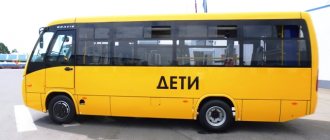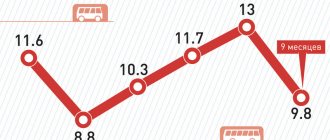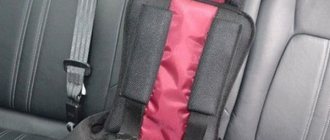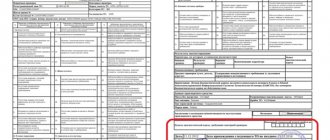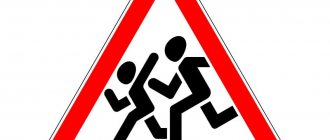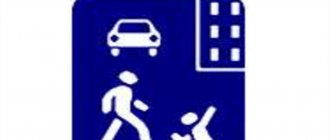The April innovations of the 2021 traffic rules regarding the transportation of children made a number of changes not only to the conditions for their placement in the car, but also with regard to the use of the corresponding sticker.
Dear readers! The article talks about typical ways to resolve legal issues, but each case is individual. If you want to find out how to solve your particular problem , contact a consultant:
+7 (499) 938-81-90 (Moscow)
+7 (812) 467-32-77 (Saint Petersburg)
8 (800) 301-79-36 (Regions)
APPLICATIONS AND CALLS ARE ACCEPTED 24/7 and 7 days a week.
It's fast and FREE !
In this situation, novice drivers should take into account that the specifics of use, appearance and application conditions are regulated by current legislation. Therefore, it can only look according to the approved sample.
The presence of the drawing shown in the photograph has nothing to do with this and cannot be regarded as the driver fulfilling his duties.
Identification sign “Transportation of children” on buses
The placement of this sign indicates that there are children in the vehicle. Such transportation can be carried out only if all legal norms are observed, since their violation may result in serious administrative punishment, which extends from drivers to officials.
The sign is an identification sign; it indicates the fact of organized transportation. The sign must be located on both the front and rear of the bus.
The presence of such a sign indicates the performance of certain functions:
- notifies all other road users about the presence of children in the vehicle;
- enables the traffic police to organize traffic in accordance with priorities.
Also, the identification mark gives the following characteristics to the bus that carries out transportation:
- children traveling in the cabin in the amount of 8 or more people;
- there are children in the cabin without official representatives;
- The speed of the vehicle is limited in accordance with the Traffic Rules.
The age of children traveling in a vehicle with the “Transportation of Children” sign is not specified either in Resolution No. 1177 or in clause 22.6 of the Traffic Regulations.
Previously, drivers could find such information in the “Technical Requirements for Buses for Transporting Children,” Chapter 1. It was stated there that these requirements apply to vehicles carrying children aged 6 to 16 years on board, and the standard is intended only for travel in roads of the Russian Federation.
Rules for a passenger car
With regard to a passenger car, there is a twofold situation here. If you follow the traffic rules, any car containing children must be equipped with a sign.
This condition has been in effect since April 4, 2021, when further changes were introduced, but more on that later, but we should start with the transportation rules. The above conditions apply to transporting a child on a bus during an organized bus trip.
The article will tell you about the models of bicycle trailers for transporting children: Bicycle trailers for transporting children. What is the price when ordering a minibus for transporting people, read here.
As for passenger transport, first of all, you should adhere to clause 22.9 of the Traffic Regulations of the Russian Federation, that is, the conditions that children under 7 years old must be in a special car seat that meets the requirements of current legislation.
Upon reaching this age, transportation in the rear seat is carried out at the discretion of the driver, in the front seat - strictly with the use of a child restraint system. This requirement applies to cars and trucks. The information provided characterizes the conditions for transporting a child.
The answer to the question: is a sign for children in a car needed on a personal car can be traced by the following analysis of legislation:
- Let’s take the traffic rules into our hands again, in the “Basic provisions on admission ...”, paragraph 8 there is a list of identification marks that must be installed on the vehicle without fail. In paragraph 3 there is information that the presence of a sign is mandatory, as well as others:
- thorns;
- road train;
- deaf driver and so on.
- Based on this, every personal car in which a child is transported (to school, kindergarten, store and for other purposes) must have a “Caution for Children” sticker. This is once again confirmed by the reference to the Code of Administrative Offenses of the Russian Federation, Art. 12.5 clause 1, which implies an administrative violation for this.
The fact that at the moment this criterion is not considered by traffic police officers remains unknown, since in the situation there is a direct connection between the above-mentioned requirements of the traffic rules and the Code of Administrative Offences.
The legislation does not specify up to what age it should be applied, since the conditions presented in GOST 33552-2015 affect the situation regarding buses.
"Children" sign for a bus according to GOST
You can purchase such a sign without any problems at any car store, but you should know that it must meet certain requirements established by law.
The sign was developed according to the provisions of the Vienna Convention, which regulates the rules for printing and placement of such signs. Such stickers usually look the same: it is a yellow square with a red border, in the center of which there are two black silhouettes of running children.
The size will depend on the location on the bus:
- When the sign is placed on the front of the bus, its dimensions are 25 cm.
- If placed on the back - 40 cm.
- The width of the red border is always 0.1 part of the side.
If such standards are not met, the traffic police have every right to fine the driver.
The rules regarding the installation and fort of the sign are specified in the Rules of the Road. At the moment, this information is located in paragraph 9.3.
There are also special GOSTs related to the requirements imposed on the vehicle on which transportation will be carried out. At the moment this is GOST R 51160-98.
The sign should be positioned as follows:
- in front - on the windshield in the upper right part, as this will not interfere with the view;
- rear - place on a metal door.
The cost of a sign varies depending on its size and material of manufacture:
- 60*25/60*30 cm, made of polyvinyl chloride with a calendered surface, covered with mounting film - 300/400 rubles;
- 25*25/30*30 cm, made of polyvinyl chloride with a calendered surface, covered with mounting film - 60/90 rubles;
- 25*25/30*30 cm, printed on PVC, after which the image is glued to a rigid base - 350/450 rubles.
What other designations should there be?
An additional sign used in this case can be considered the “Speed Limit” sticker.
It looks like this:
- The appearance is identical to the reduced color image of prohibition sign 3.24 shown in the photo.
- Diameter no less than 16 cm.
- The width of the border is a tenth of the diameter, that is, at least 1.6 cm.
The place where it is installed is defined as the lower part of the body. In the presented image, the driver stuck it in the middle, which can also be regarded as a violation with all the ensuing consequences.
It must be emphasized that the requirement to have a sticker limiting the maximum speed of the vehicle applies only to buses and minibuses intended for organized transportation.
There are no speed restrictions for passenger cars with a child in the cabin.
Fine for missing a sign
If there is a negligent attitude to the rules and the absence of an identification mark, the driver is subject to administrative liability. According to Resolution No. 333 of March 24, 2017, punishment is imposed and applied based on the conditions specified in Article 12.5 Part 1 of the Code of Administrative Offenses of the Russian Federation. This could be either a warning or a fine of 500 rubles. The traffic police officer has the right to determine the punishment based on the situation.
Rules for organized transportation
According to traffic rules, organized transportation of children is a trip in which there are at least 8 children unaccompanied by parents in a vehicle that is not a route vehicle.
Transportation is possible only after fulfilling all the requirements for:
- driver;
- passengers;
- bus;
- documents.
The transportation rules include the following points:
- traffic police officers provide escort;
- the driver must meet all requirements;
- prepare a package of documents for the trip;
- ensuring compliance with requirements by accompanying persons;
- follow the rules for boarding/disembarking passengers on the bus.
Support by the State Inspectorate
The traffic police should accompany the trip only if it is a convoy with at least 3 vehicles in it.
The organizer must obtain permission to transport children, and then give the original to the driver, who must keep it in the vehicle for 3 days from the start of the trip and present it to the traffic police officer upon request. If the number of buses does not exceed 3, then an application for travel permission can be submitted approximately 2 days before the trip, and if from 3, then 10 days before. To find out how the application procedure goes and what else is needed for this, you can go to the official website of the State Traffic Inspectorate.
Transportation under parental supervision
Parents or guardians on the bus are not considered accompanying persons, which means that the trip loses the status of organized transportation, which is why the rules listed above and below do not apply to it.
Documentation
We will consider all the necessary documents for organized transportation.
Traffic police document
When drawing up an application for permission to organize transportation, the following information should be indicated:
- travel route;
- duration of support;
- attendant's initials;
- drivers' initials, details of their driver's license;
- number of passengers;
- license plates of buses.
Data on the trip of 1 or 2 buses must also be transferred to the traffic police. Please indicate:
- date of transportation;
- information about the company that organized the trip;
- number of minor passengers and their age;
- travel route;
- attendant's initials;
- make and license plate number of the bus.
List of children and designated chaperones
The list must indicate the child’s last name, first name and patronymic, his age and, necessarily, the contact telephone number of his parents or guardians. In the list of assigned accompanying persons, just as in the case of the list of children, it is necessary to indicate first names, last names and patronymics, as well as their telephone numbers.
Driver's document
Here his name, surname, patronymic and telephone number are indicated. If there are several drivers, then several contacts are indicated. We're not talking about a driver's license. The trip organizer must prepare a separate document containing information about the carrier.
Route program
The route program includes:
- travel schedule with estimated transportation time;
- a list of stops so that there is an opportunity to relieve physiological needs, eat, relax, and also go on excursions.
Additional documents
Sometimes the following additional documents may be required:
- a travel contract signed by the transport company and the customer, if it was concluded;
- medical worker's document;
- license to carry out medical activities;
- a list of necessary food products if the trip lasts more than 3 hours;
- list of tourism operator employees.
Requirements for passengers of organized transportation of children
According to clause 9 of the Decree of the Government of the Russian Federation of December 17, 2013 N 1177, it is prohibited to include children under 7 years of age in bus transportation on routes that require more than 4 hours to cover.
The inclusion of children under 7 years of age in a group of children for organized transportation by bus when they are on the route according to the schedule for more than 4 hours is not allowed.
clause 9 of the Decree of the Government of the Russian Federation of December 17, 2013 N 1177
There must be accompanying persons on the bus who monitor the safety of children during the trip. According to clause 14 of the Rules for the organized transportation of a group of children, an accompanying person must be at each door of the bus.
The number of accompanying persons per 1 bus is assigned based on their location at each bus door intended for boarding (disembarking) passengers, while one of the accompanying persons is responsible for the organized transportation of a group of children on the corresponding bus and coordinates the actions of the driver (drivers) and other accompanying persons in the specified bus.
clause 14 of the Rules for organized transportation of a group of children
New rules for transporting children on long-distance buses in 2021 make it mandatory to be accompanied by a medical professional if the route takes more than 12 hours.
When organizing transportation of a group of children in intercity traffic by an organized transport convoy for more than 12 hours according to the traffic schedule, the head or official responsible for ensuring road safety, the organization, and in the case of organized transportation of a group of children under a charter agreement - the charterer or charterer (by mutual agreement ) ensures that such a group of children is accompanied by a medical worker who has a copy of the license to carry out medical activities or a copy of the agreement with a medical organization or individual entrepreneur who has the appropriate license.
clause 12 of the Russian Federation Regulations dated 12/17/2013 N 1177
According to the requirements established in paragraph 18 of the Decree of the Government of the Russian Federation of December 17, 2013 N 1177, it is prohibited to transport persons who are not included in the list of passengers on a bus that transports children.
Requirements for drivers and transport
According to clause 8 of RF PP No. 1177, a driver will be able to drive a bus with children if he has:
- driving license category D;
- driving experience of driving a bus directly must be at least one year out of the last 3 years;
- completed instructions on transporting children;
- were not found guilty of administrative offenses under Chapter 12 of the Code of Administrative Offenses of the Russian Federation;
- he was not deprived of his rights;
- medical access.
This resolution also describes the requirements for the bus:
- the bus must be under 10 years old;
- it must meet technical requirements;
- a document confirming the passage of a technical inspection confirming the serviceability of the bus;
- There must be a tachograph - a device that will monitor the speed of the bus and the driver’s work and rest schedule.
Unorganized transportation of children on the bus
There is no concept of unorganized transportation of children in the traffic rules. Based on the definition of organized transportation of a group of children, we can distinguish that unorganized transportation includes the following:
in route vehicles;
with children accompanied by their parents or other legal representatives;
groups of children less than 8 people.
In this case, the Rules for the organized transportation of children established by Decree of the Government of the Russian Federation of December 17, 2013 N 1177 do not apply.
Rules for boarding and disembarking
On the way, the rules for getting in and out of the vehicle must be followed. Before placing children on the bus, the following measures must be taken:
- Check the presence of children according to the previously approved list.
- Gather children no less than 15 meters from the landing site.
- Load luggage.
- Check your hand luggage and how it is packed in accordance with the Rules.
- Discuss with the accompanying persons all the nuances and questions of the following nature: how to behave while driving and at stops;
- how passengers will board and disembark;
- how to behave in emergency situations or in case of health problems.
The task of the accompanying persons is to monitor the condition, well-being, behavior of the children, as well as what they eat.
Boarding begins only after the vehicle has stopped. The accompanying pairs bring the children to the front door of the bus, take them inside, and then seat them. It is also necessary to ensure that hand luggage is placed so that it does not injure anyone or obscure the driver’s view. Inform the driver about the end of boarding.
The adults leave the bus first. At stops, one adult stands at the back of the vehicle, and the second at the front. Their task is to prevent children from running out onto the road.
Transportation at night
According to Decree of the Government of the Russian Federation No. 1177 of December 17, 2013, at night (from 11 pm to 6 am), the route distance cannot exceed more than 100 km, and you can only go if necessary:
- transport to or from railway stations, airports;
- to the final destination;
- in case of unplanned delay.
If these resolutions were violated, then in accordance with Part 5 of Article 12.23 of the Code of Administrative Offenses of the Russian Federation one of the following penalties will be applied:
- for the driver the fine is 5,000 rubles. or deprivation of a driver's license for a period of 4 to 6 months;
- for officials the fine is 50,000 rubles;
- for legal entities - 200,000 rubles. fine
It should be understood that the process of transporting children is strictly controlled by current legislation, since the safety of children is an important issue and should not be neglected. Any violation of all basic rules may result in serious problems with the law and its representatives.
School bus requirements in 2021
As we said above, the technical requirements for buses for transporting children in accordance with GOST 33552-2015 include the mandatory equipping of the bus with identification marks “Transportation of Children” in the front and rear of the vehicle, as well as the inscriptions “CHILDREN” on each side of the bus.
It is also mandatory to install a “Speed Limit” sign. The 60 sign must be located at the left rear of the bus and be at least 16 cm in diameter.
8. Vehicles must be equipped with identification signs: “Speed limit” - in the form of a reduced color image of road sign 3.24 indicating the permitted speed (sign diameter - at least 160 mm, border width - 1/10 of the diameter) - on the rear side of the body on the left of motor vehicles carrying out organized transportation of groups of children...
clause 8 Basic provisions for the admission of vehicles to operation and the duties of officials to ensure road safety, traffic rules.
In addition to the requirements for the external equipment of buses, there are also technical ones. The bus must be equipped with a tachograph and GLONASS satellite navigation. It should also be remembered that on July 1, 2021, the requirements of clause 3 of Decree of the Government of the Russian Federation of December 17, 2013 N 1177, regarding the year of manufacture of the bus, came into force, according to which it cannot be older than 10 years:
To carry out the organized transportation of a group of children, a bus is used, from the year of manufacture of which no more than 10 years have passed, which corresponds in purpose and design to the technical requirements for the transportation of passengers, is approved in the prescribed manner to participate in road traffic and is equipped in the prescribed manner with a tachograph, as well as equipment satellite navigation GLONASS or GLONASS/GPS and equipped with seat belts.
clause 3 of the Decree of the Government of the Russian Federation of December 17, 2013 N 1177
So, the requirements for what a bus for transporting children should be equipped with include:
- Sign “Transportation of children”;
- Inscriptions "CHILDREN";
- Speed limit sign;
- Tachograph;
- Satellite navigation GLONASS.
